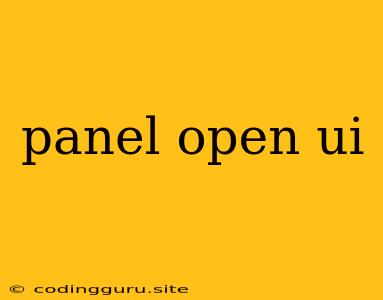What is a Panel Open UI?
A Panel Open UI refers to a user interface (UI) design pattern that involves using panels to organize and present information in a structured and visually appealing way. These panels are often used to display different sections of content, functionalities, or data within a larger application or web page.
Why use Panel Open UIs?
Panel Open UIs are popular due to their versatility and ability to enhance user experience. Here's why:
- Organization: Panels help structure information, making it easy for users to navigate and understand the layout.
- Modularity: Each panel can be independently developed and managed, promoting code reusability and easier maintenance.
- Flexibility: Panels can be dynamically added, removed, or resized, allowing for adaptable layouts based on user needs.
- Visual Appeal: Panels create visual separation between different content areas, improving readability and aesthetic appeal.
Key Features of a Panel Open UI:
- Panel Structure: Typically, panels are rectangular containers with a defined border, title bar, and content area.
- Content Display: Panels can contain text, images, charts, graphs, forms, or any other relevant content.
- Interactions: Panels often have interactive elements like buttons, sliders, or dropdowns to control their visibility, functionality, or data display.
- Responsiveness: Panel Open UIs should be responsive to different screen sizes and devices, ensuring optimal viewing experience.
Types of Panel Open UIs:
There are several variations of Panel Open UI implementations, depending on the application's specific requirements:
- Tabbed Panels: Panels grouped together using tabs, allowing users to switch between different sections of content.
- Accordion Panels: Panels that expand or collapse when clicked, providing a compact and space-saving layout.
- Card Panels: Panels designed for displaying individual items or data points, often used in dashboards or content galleries.
- Side Panels: Panels positioned along the edges of the screen, often used for navigation, menus, or toolbars.
How to implement a Panel Open UI?
Implementing a Panel Open UI typically involves using a UI framework or library that provides the necessary components and functionality. Popular options include:
- React: A JavaScript library that enables building interactive user interfaces with components like React Bootstrap or Material-UI.
- Angular: A framework for building web applications, which offers a comprehensive set of tools for creating panels and other UI elements.
- Vue.js: A progressive framework for building web interfaces, providing a simple and flexible approach to component-based development.
Tips for Designing Effective Panel Open UIs:
- Clear Titles and Labels: Use informative titles and labels to clearly communicate the purpose and content of each panel.
- Consistent Styling: Maintain consistency in panel appearance and styling throughout the application for a unified look and feel.
- Optimized Layout: Ensure that panels are sized appropriately and positioned effectively for optimal viewing experience.
- User Feedback: Provide visual feedback to users on their interactions with panels, such as animation or highlighting.
Conclusion:
Panel Open UIs are a versatile and effective design pattern that can greatly enhance the organization, navigation, and visual appeal of your application or web page. By understanding the key features, types, and implementation methods, you can effectively use Panel Open UIs to create user-friendly and engaging interfaces.
